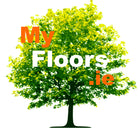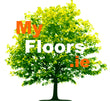Useful Terminology
Engineered Floors: Engineered wood flooring gives you all the beauty of solid wood but with more stability and a lighter footprint on the environment. It is made with two key layers, the base is made from high quality plywood its thickness can vary from 11mm to 15mm. The top layer is from your chosen hardwood and the thickness can vary from 3mm to 6mm. Overall board thickness can vary from 13mm to 21mm. By joining these two together the product becomes much more stable. Engineered flooring can be sanded, the number of times that sanding can take place will depend on the depth of the top layer.
Solid Floors: Solid wood flooring is pure wood all the way through the plank, it is made from one single cut of wood. Solid flooring can be hardwood eg Oak / Maple or softwood eg Pine. Solid floors are more prone to expansion, contraction and movement. High humidity, or excessive washing will cause solid floors to swell. Solid floors can be sanded. In general solid wood flooring comes in 18mm to 22m thickness.
Laminated Floors: A printed paper/picture with protective laminated plastic layer to protect it, all bonded to a fiber board. Some laminated floors can have a textured effect to mimic wood grain. Laminate wood flooring is a very practical floor covering, the fact that it is easy to clean and durable, makes it an ideal option for your home or project. Designs have improved massively over the last 10 years and know its appearance can be on par with real wood flooring.
Parquet: A designed / pattern floor eg: herringbone. Parquet can be purchased as solid, engineered or laminate floor
Humidity: Humidity is the concentration of water vapour present in the air. Wood is a natural material that constantly reacts to variations in temperature and humidity. Ideally the internal moisture level of wood should be between 6% to 9%. Wood swells when it absorbs excess humidity from the air and contracts when the humidity levels fall to low. Floorboards with higher than normal moisture levels may bulge slightly, whereas spaces will appear between the floorboards if moisture levels are too low. Generally wood resumes its original dimensions when conditions return to normal.
Prefinished: Floors that have had a finish coat applied prior to fitting and require no further finishing after installation.
Hardwood: Deciduous broad leaf trees as opposed to conifers (softwoods)
Sapwood: Young wood outside of tree usually lighter in colour than the wood at the center of the tree.
Vapour Moisture Barrier: A layer that resists vapour/moisture movement. Polythene usually acts as a very efficient moisture barrier and is a cheap layer for insurance.
Tongue & Groove: Tongue juts out over one side of the timber and slots into groove in opposite side to give floor strength and stability
Thickness: Thickness is the total depth of the board. Needs to considered in design phase if matching to tiles, fireplace, other flooring, external door clearance.
AC rating: AC Rating is an industry standard for the abrasive class of the top layer of the laminate. AC3/AC4 suitable for domestic use, AC5/6 heavy commercial.
Wear Layer: Wear Layer is the depth of solid wood on top of the engineered ply backing.
Installation Type: Installation Type is the method by which the floor can be installed example floated, glued or nailed. Installation type is dependant on the type of floor being installed.
Wood Species: Wood Species is the natural tree of origin for the floor, Engineered / Solid.
Pack Size: Pack size is the coverage of each box in m2
Length: Length refers to how long each board is in meters. Random lengths means there is a mix of lengths in each box.
Softwood: Comes from cone and needle producing trees (conifers)
Heartwood: The wood extending from the path of the sapwood, it is the mature wood that forms the spine of the tree.
Maple: (Canadian) A hard wearing heavy straight grained wood with fine texture. The sapwood is white and light in colour, the heart wood is alight reddish brown. The wood is hard wearing.
Birch: (Canadian) Light yellow sapwood and reddish brown heart heartwood. Quite colourful
Hickory: Wavy grain pattern, sapwood is white, heartwood is reddish brown.
Ebony: Dense heavy wood, irregular wavy grain, sapwood is yellowish white; the heartwood is a lustrous dark brown to black
Beech: Whitish Brown turning yellowish, on exposure with a pinky tone
Ash: Straight grained wood and almost white sapwood and pale brown heartwood
Walnut: Sapwood light creamy colour contrasting with rich brown to purplish – black heartwood. Straight and wavy grain.
Cherry (American) Heartwood is reddish brown to deep red with brown flecks. Sapwood is pink on colour.
Oak (American) Pale yellow brown to pale brown and can have a pink/reddish tinge to it.
Oak (European) Straight grain, pale yellowish brown heartwood and even paler sapwood.
Red Oak: Similar to American Oak but has significantly more red/pink colouring to it along with brown.
Acacia: Golden brown to dark brown in colour often stained for flooring purposes
Pine: A softwood, yellow and red in colour turning gold with time, very knotty.

